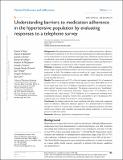Understanding barriers to medication adherence in the hypertensive population by evaluating responses to a telephone survey
Author(s)
Nair, KV; Belletti, DA; Doyle, JJ; Allen, RR; McQueen, RB; Saseen, JJ; Griend, JV; Patel, JV; McQueen, A; Jan, S; ... Show more Show less
DownloadPublished version (341.1Kb)
Publisher with Creative Commons License
Publisher with Creative Commons License
Creative Commons Attribution
Terms of use
Metadata
Show full item recordAbstract
Background: Although hypertension is a major risk factor for cardiovascular disease, adherence to hypertensive medications is low. Previous research identifying factors influencing adherence has focused primarily on broad, population-based approaches. Identifying specific barriers for an individual is more useful in designing meaningful targeted interventions. Using customized telephonic outreach, we examined specific patient-reported barriers influencing hypertensive patients' nonadherence to medication in order to identify targeted interventions. Methods: A telephone survey of 8692 nonadherent hypertensive patients was conducted. The patient sample comprised health plan members with at least two prescriptions for antihypertensive medications in 2008. The telephone script was based on the "target" drug associated with greatest nonadherence (medication possession ratio [MPR] <80%) during the four-month period preceding the survey. Results: The response rate was 28.2% of the total sample, representing 63.8% of commercial members and 37.2% of Medicare members. Mean age was 63.4 years. Mean MPR was 61.0% for the target drug. Only 58.2% of Medicare respondents and 60.4% of commercial respondents reported "missing a dose of medication". The primary reason given was "forgetfulness" (61.8% Medicare, 60.8% commercial), followed by "being too busy" (2.7% Medicare, 18.5% commercial) and "other reasons" (21.9% Medicare, 8.1% commercial) including travel, hospitalization/sickness, disruption of daily events, and inability to get to the pharmacy. Prescription copay was a barrier for less than 5% of surveyed patients. Conclusion: Our findings indicate that events interfering with daily routine had a significant impact on adherence. Medication adherence appears to be a patterned behavior established through the creation of a routine and a reminder system for taking the medication. Providers should assess patients' daily schedules and medication-taking competency to develop and promote a medication routine. © 2011 2011 Nair et al, publisher and licensee Dove Medical Press Ltd.
Date issued
2011-12-01Department
Sloan School of ManagementJournal
Patient Preference and Adherence
Publisher
Informa UK Limited
Citation
Nair, KV, Belletti, DA, Doyle, JJ, Allen, RR, McQueen, RB et al. 2011. "Understanding barriers to medication adherence in the hypertensive population by evaluating responses to a telephone survey." Patient Preference and Adherence, 5.
Version: Final published version